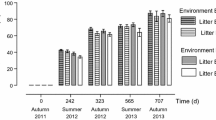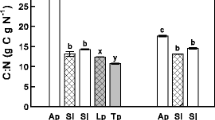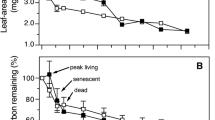Abstract
Mutualisms can strongly affect the structure of communities, but their influence on ecosystem processes is not well resolved. Here we show that a plant–microbial mutualism affects the rate of leaf litter decomposition using the widespread interaction between tall fescue grass (Lolium arundinaceum) and the fungal endophyte Neotyphodium coenophialum. In grasses, fungal endophytes live symbiotically in the aboveground tissues, where the fungi gain protection and nutrients from their host and often protect host plants from biotic and abiotic stress. In a field experiment, decomposition rate depended on a complex interaction between the litter source (collected from endophyte-infected or endophyte-free plots), the decomposition microenvironment (endophyte-infected or endophyte-free plots), and the presence of mesoinvertebrates (manipulated by the mesh size of litter bags). Over all treatments, decomposition was slower for endophyte-infected fescue litter than for endophyte-free litter. When mesoinvertebrates were excluded using fine mesh and litter was placed in a microenvironment with the endophyte, the difference between endophyte-infected and endophyte-free litter was strongest. In the presence of mesoinvertebrates, endophyte-infected litter decomposed faster in microenvironments with the endophyte than in microenvironments lacking the endophyte, suggesting that plots differ in the detritivore assemblage. Indeed, the presence of the endophyte in plots shifted the composition of Collembola, with more Hypogastruridae in the presence of the endophyte and more Isotomidae in endophyte-free plots. In a separate outdoor pot experiment, we did not find strong effects of the litter source or the soil microbial/microinvertebrate community on decomposition, which may reflect differences between pot and field conditions or other differences in methodology. Our work is among the first to demonstrate an effect of plant–endophyte mutualisms on ecosystem processes under field conditions.




Similar content being viewed by others
References
Ball DM, Pedersen JF, Lacefield GD (1993) The tall fescue endophyte. Am Sci 81:370–379
Bever JD, Westover KM, Antonovics J (1997) Incorporating the soil community into plant population dynamics: the utility of the feedback approach. J Ecol 85:561–573
Bland RG, Jacques HE (1978) How to know the insects. Wm. C. Brown Company, Dubuque, Iowa
Borrer DJ, Triplehorn CA, Johnson NF (1989) An introduction to the study of insects. Harcourt Brace & Company, Orlando, FL
Bradford MA, Tordoff GM, Eggers T, Jones TH, Newington JE (2002) Microbiota, fauna, and mesh size interactions in litter decomposition. Oikos 99:317–323
Breen JP (1994) Acremonium/endophyte interactions with enhanced plant resistance to insects. Annu Rev Entomol 39:402–423
Bruno JF, Stachowicz JJ, Bertness MD (2003) Inclusion of facilitation into ecological theory. Trends Ecol Evolut 18:119–125
Bush LP, Wilkinson HH, Schardl CL (1997) Bioprotective alkaloids of grass–fungal endophyte symbioses. Plant Physiol 114:1–7
Clay K (1990) Fungal endophytes of grasses. Annu Rev Ecol Systemat 21:275–297
Clay K (1994) The potential role of endophytes in ecosystems. In: Bacon CW, White JF (eds) Biotechnology of endophytic fungi of grasses. CRC Press, Boca Raton, FL, pp 73–86
Clay K (1996) Interactions among fungal endophytes, grasses and herbivores. Res Populat Ecol 38:191–201
Clay K (2001) Symbiosis and the regulation of communities. Am Zool 41:810–824
Clay K, Holah J (1999) Fungal endophyte symbiosis and plant diversity in successional fields. Science 285:1742–1744
Clay K, Schardl C (2002) Evolutionary origins and ecological consequences of endophyte symbiosis with grasses. Am Natural 160:S99–S127
Clay K, Cheplick GP, Marks S (1989) Impact of the fungus Balansia henningsiana on Panicum agrostoides: frequency of infection, plant growth and reproduction, and resistance to pests. Oecologia (Berlin) 80:374–380
Clay K, Marks S, Cheplick GP (1993) Effects of insect herbivory and fungal endophyte infection on competitive interactions among grasses. Ecology 74:1767–1777
Curry JP (1969) The decomposition of organic matter in soil. Part 1: the role of the fauna in decaying grassland herbage. Soil Biol Biochem 1:253–258
Ehrenfeld JG (2003) Effects of exotic plant invasions on soil nutrient cycling processes. Ecosystems 6:503–523
Elmi AA, West CP (1995) Endophyte infection effects on stomatal conductance, osmotic adjustment and drought recovery of tall fescue. New Phytol 131:61–67
Filser J (2002) The role of Collembola in carbon and nitrogen cycling in soil. Pedobiologia 46:234–245
Fountain MT, Hopkin SP (2005) Folsomia candida (Collembola): a “standard" soil arthropod. Annu Rev Entomol 50:201–222
Franzluebbers AJ, Nazih N, Stuedemann JA, Fuhrmann JJ, Schomberg HH, Hartel PG (1999) Soil carbon and nitrogen pools under low- and high-endophyte-infected tall fescue. Soil Sci Soc Am J 63:1687–1694
Gartner TB, Cardon ZG (2004) Decomposition dynamics in mixed-species leaf litter. Oikos 104:230–246
Grime JP, Cornelissen JHC, Thompson K, Hodgson JG (1996) Evidence of a causal connection between anti-herbivore defence and the decomposition rate of leaves. Oikos 77:489–494
Gwinn KD, Gavin AM (1992) Relationship between endophyte infection level of tall fescue seed lots and Rhizoctonia zeae seedling disease. Plant Disease 76:911–914
Hansen RA (1999) Red oak litter promotes a microarthropod functional group that accelerates its decomposition. Plant Soil 209:37–45
Hartnett DC, Wilson GWT (1999) Mycorrhizae influence plant community structure and diversity in tallgrass prairie. Ecology 80:1187–1195
Hector A, Beale AJ, Minns A, Otway SJ, Lawton JH (2000) Consequences of the reduction of plant diversity for litter decomposition: effects through litter quality and microenvironment. Oikos 90:357–371
van der Heijden MGA et al (1998) Mycorrhizal fungal diversity determines plant biodiversity, ecosystem variability and productivity. Nature 396:69–72
Heyman S, Weaver J (1997) The Collembola. MOFEP Arthropods Key. http://www.missouri.edu/~bioscish/coll.html. In, vol. 2004
Hiebert RD (1990) An ecological restoration model: application to razed residential sites. Nat Areas J 10:181–186
Hill NS (1994) Ecological relationships of Balansiae-infected graminoids. In: Bacon CW, White JF (eds) Biotechnology of endophytic fungi of grasses. CRC Press, Boca Raton, pp 59–71
Hopkin SP (1997) Biology of the Springtails (Insecta: Collembola). Oxford University Press, Oxford, UK
Hunter MD, Adl S, Pringle CM, Coleman DC (2003) Relative effects of macro invertebrates and habitat on the chemistry of litter during decomposition. Pedobiologia 47:101–115
Knops JMH, Wedin D, Tilman D (2001) Biodiversity and decomposition in experimental grassland ecosystems. Oecologia 126:429–433
Leuchtmann A (1992) Systematics, distribution, and host specificity of grass endophytes. Nat Toxins 1:150–162
Levine JM, Vila M, D’Antonio CM, Dukes JS, Grigulis K, Lavorel S (2003) Mechanisms underlying the impacts of exotic plant invasions. Proc Roy Soc Lond Ser B-Biol Sci 270:775–781
Lussenhop J (1992) Mechanisms of microarthropod–microbial interactions in soil. Adv Ecol Res 23:1–33
Lyons PC, Evans JJ, Bacon CW (1990) Effects of the fungal endophyte Acremonium coenophialum on nitrogen accumulation and metabolism in tall fescue. Plant Physiol (Rockville) 92:726–732
Mack MC, D’Antonio CM (2003) The effects of exotic grasses on litter decomposition in a Hawaiian woodland: the importance of indirect effects. Ecosystems 6:723–738
Madritch MD, Hunter MD (2003) Intraspecific litter diversity and nitrogen deposition affect nutrient dynamics and soil respiration. Oecologia 136:124–128
Malinowski DP, Alloush GA, Belesky DP (2000) Leaf endophyte Neotyphodium coenophialum modifies mineral uptake in tall fescue. Plant Soil 227:115–126
Maron JL, Connors PG (1996) A native nitrogen-fixing shrub facilitates weed invasion. Oecologia (Berlin) 105:302–312
Mebes KH, Filser J (1998) Does the species composition of Collembola affect nitrogen turnover? Applied Soil Ecology 9:241–247
Ogle SM, Reiners WA, Gerow KG (2003) Impacts of exotic annual brome grasses (Bromus spp.) on ecosystem properties of northern mixed grass prairie. Am Midland Natural 149:46–58
Olofsson J, Oksanen L (2002) Role of litter decomposition for the increased primary production in areas heavily grazed by reindeer: a litterbag experiment. Oikos 96:507–515
Omacini M, Chaneton EJ, Ghersa CM, Otero P (2004) Do foliar endophytes affect grass litter decomposition? A microcosm approach using Lolium multiflorum. Oikos 104:581–590
Petrini O (1991) Fungal endophytes of tree leaves. In: Andrews JH, Hirano SS (eds) Microbial ecology of leaves. Springer-Verlag, New York, New York, pp 179–197
Raloff J (2003) Cultivating weeds: is your yard a menace to parks and wild lands? Sci News 163:232
Rusek J (1998) Biodiversity of Collembola and their functional role in the ecosystem. Biodiversity Conserv 7:1207–1219
Salamon JA, Schaefer M, Alphei J, Schmid B, Scheu S (2004) Effects of plant diversity on Collembola in an experimental grassland ecosystem. Oikos 106:51–60
SAS Institute, Inc. (2003) SAS version 9.1. The SAS Institute, Cary, North Carolina, USA
Schadler M, Jung G, Auge H, Brandl R (2003) Palatability, decomposition and insect herbivory: patterns in a successional old-field plant community. Oikos 103:121–132
Schmidt SP et al (1982) Association of an endophytic fungus with fescue toxicity in steers fed Kentucky-31 tall fescue seed or hay. J Anim Sci 55:1259–1263
Schomberg HH, Stuedemann JA, Franzluebbers AJ, Wilkinson SR (2000) Spatial distribution of extractable phosphorus, potassium, and magnesium as influenced by fertilizer and tall fescue endophyte status. Agron J 92:981–986
Schweitzer JA et al (2004) Genetically based trait in a dominant tree affects ecosystem processes. Ecol Lett 7:127–134
Smith SE, Read DJ (1997) Mycorrhizal symbiosis, 2nd edn. Academic Press, San Diego
Sokal RR, Rohlf FJ (1995) Biometry: the principles and practice of statistics in biological research, 3rd edn. W.H. Freeman, New York
Soto-Adames FN (2002) Molecular phylogeny of the Puerto Rican Lepidocyrtus and Pseudosinella (Hexapoda: Collembola), a validation of Yoshii’s “color pattern species". Mol Phylogenet Evolut 25:27–42
Stachowicz JJ (2001) Mutualism, facilitation, and the structure of ecological communities. Bioscience 51:235–246
Standish RJ, Williams PA, Robertson AW, Scott NA, Hedderley DI (2004) Invasion by a perennial herb increases decomposition rate and alters nutrient availability in warm temperate lowland forest remnants. Biol Invasions 6:71–81
Stone JK, Bacon CW, White JF (2000) An overview of endophytic microbes: endophytism defined. In: Bacon CW, White JF (eds) Microbial endophytes. Marcel Dekker, Inc., New York, New York, pp 3–30
Thrower LB, Lewis DH (1973) Uptake of sugars by Epichloe typhina (Pers. Ex Fr.) Tul. in culture and from its host, Agrostis stolonifera L. New Phytol 72:501–508
Wardle DA (2002) Communities and ecosystems: linking the above-ground and below-ground components. Princeton University Press
Wardle DA, Bonner KI, Barker GM (2002) Linkages between plant litter decomposition, litter quality, and vegetation responses to herbivores. Funct Ecol 16:585–595
Wilson D (1995) Fungal endophytes which invade insect galls: insect pathogens, benign saprophytes, or fungal inquilines? Oecologia (Berlin) 103:255–260
Acknowledgements
Many thanks to Joseph Reznik for assistance identifying Collembola, Jessica Stuaan for sorting Collembola, Jon Dahl for tissue analysis, Keenan Mack and Brette Thompson for help in the field, and two anonymous reviewers for helpful comments on the manuscript. This research was funded by a Howard Hughes Medical Institute Undergraduate Research Capstone Award to A.L., by NSF DBI-0200485 to J.A.R., and by NSF DEB-9727116 to K.C. All experiments complied with the current laws of the USA.
Author information
Authors and Affiliations
Corresponding author
Additional information
Communicated by Alan Knapp
Rights and permissions
About this article
Cite this article
Lemons, A., Clay, K. & Rudgers, J. Connecting plant–microbial interactions above and belowground: a fungal endophyte affects decomposition. Oecologia 145, 595–604 (2005). https://doi.org/10.1007/s00442-005-0163-8
Received:
Accepted:
Published:
Issue Date:
DOI: https://doi.org/10.1007/s00442-005-0163-8




